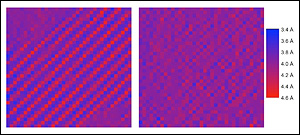News Story
Electron Microscopy Inspires Flexoelectric Theory Behind "Material on the Brink"

Atomic spacing map derived from high resolution electron microscopy shows marked modulation in positions of atoms in BSFO.
A research team including ORNL's Albina Borisevich examined thin films of bismuth samarium ferrite, known as BSFO, which exhibits unusual physical properties near its transition from one phase to another. BSFO holds potential as a lead-free substitute for lead zirconium titanate (PZT), a similar material currently used in dozens of technologies from sensors to ultrasound machines.
BSFO, discovered using the combinatorial approach by MSE professor Ichiro Takeuchi and his colleagues in 2008, is synthesized by pulsed laser deposition at the University of Maryland. Takeuchi and his team, who have dedicated themselves to the ongoing characterization of BSFO and its development for eventual commercial use, received a U.S. patent for the material in May.
Takeuchi’s team recently collaborated with Borisevich's to further their investigation. "The fascinating properties of BSFO continue to attract the attention of the community," Takeuchi explains. "We knew that there were interesting nanometer scale structures in the material, but ORNL was able to directly study the inner workings of BSFO at the atomic level, and the results were totally surprising."
Materials such as BSFO and PZT are often called "materials on the brink" in reference to their enigmatic behavior, which is closely tied to the transition between two different phases. These phases are characterized by structural changes in the material that produce different electrical properties.
"The best properties of the material are found at this transition," Borisevich says. "However, there has been a lot of discussion about what exactly happens that leads to an enhancement of the material's properties."
Using aberration-corrected scanning transmission electron microscopy, the team mapped the position of atoms in BSFO films to find what happens to the local structure at the transition between ferroelectric and antiferroelectric phases. The results were published in the April 2012 issue of Nature Communications.
"We discovered that neither of the two dominant theories could describe the observed behavior at the atomic scale," says Borisevich.
Some theorists have proposed that the material forms a nanocomposite at the transition. In this case, the energy of the boundaries between phases would have to approach zero, but Borisevich's team found experimentally something entirely different: the boundary's energy was instead effectively negative.
"When the energy of boundary is negative, it means that the system wants to have as many boundaries as possible, but with atom sizes being finite, you can't increase it to infinity," Borisevich explains. "So you have to stop at some short-period modulated structure, which is what happens here."
Based on its observations, the team concluded that the mechanism behind the observed behavior was linked to a relatively weak interaction called flexoelectricity.
"Flexoelectricity means that you bend a material and it polarizes," says ORNL coauthor Sergei Kalinin. "It's a property present in most ferroelectrics. The effect itself is not necessarily very strong on macroscopic scales, but with the right conditions, which are realized in nanoscale systems, it can produce very interesting consequences."
Borisevich adds that the team's approach can be used to investigate a variety of systems with similar phase boundaries, and she emphasizes the importance of mapping out materials at the atomic scale.
"In this particular case, electron microscopy is the only way to look at very local changes because this material is a periodic structure," she says. "The decisive atomic-scale information had been missing from the discussion."
The work was carried out in collaboration with MSE alumnus Nagarajan Valanoor (Ph.D. '01) , currently an associate professor at the University of New South Wales, Australia.
Story courtesy of and adapted from the original by Morgan McCorkle, Oak Ridge National Laboratory.
For More Information:
"Reducing Our Lead Footprint" »
"Atomic-scale evolution of modulated phases at the ferroelectric–antiferroelectric morphotropic phase boundary controlled by flexoelectric interaction." A.Y. Borisevich, E.A. Eliseev, A.N. Morozovska, C.-J. Cheng, J.-Y. Lin, Y.H. Chu, D. Kan, I. Takeuchi, V. Nagarajan, and S.V. Kalinin. Nature Communications, 2012, 3:775. Abstract »
Published June 4, 2012









